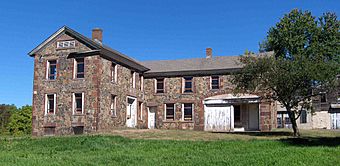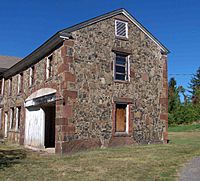Oliver Filley House facts for kids
Quick facts for kids |
|
|
Capt. Oliver Filley House
|
|

South profile, 2010
|
|
| Lua error in Module:Location_map at line 420: attempt to index field 'wikibase' (a nil value). | |
| Location | Bloomfield, CT |
|---|---|
| Nearest city | Hartford |
| Area | 144.4 acres (58.4 ha) |
| Built | 1834 |
| Architectural style | Greek Revival |
| NRHP reference No. | 07000420 |
| Added to NRHP | May 15, 2007 |
The Oliver Filley House is a historic home located at 130 Mountain Avenue in Bloomfield, Connecticut. This house was built in the Greek Revival style. It was once the home of Captain Oliver Filley and his family. Oliver Filley was a tinsmith, someone who made things out of tin. He also served as a captain in the Connecticut militia, which was like a local army, during the War of 1812.
Contents
Who Was Captain Oliver Filley?
Oliver Filley's Family and Business
After the American Revolutionary War, Oliver Filley Sr. bought land and a house in Wintonbury. He passed away in 1796 when he was 39 years old. He left part of the family farm to his son, Oliver Jr., who was only 12 at the time.
Oliver Jr. first received nine acres of land. But he worked hard to buy more land over time. Eventually, he made the farm even bigger than it was originally. In 1806, he started a business making things out of tin. This was a year after he married Annis Humphrey from nearby Simsbury. His business grew very well. He even expanded his operations to include manufacturing and storage in Elizabethtown, New Jersey.
Captain Filley's Role in the War of 1812
Filley ran his business from New Jersey for a while. However, the War of 1812 forced him to return to Connecticut. This war was a conflict between the United States and Great Britain.
In 1812, Oliver Filley was made a captain. He was put in charge of forty militiamen, who were local soldiers. Even though he was a captain, he did not fight in any battles. The British forces did not reach as far north as Connecticut during the war.
About the Oliver Filley House
Building a Unique Stone Home
Oliver Filley built this house for his son, Jay, in 1834. It is a stone building designed in the Greek Revival style. This style often looks like ancient Greek temples. The walls are made from rough, uneven stones called rubblestone. They also use multi-colored traprock, which is another type of stone.
The house has an unusual shape. It has two parts that cross each other. The main living areas were in the west part of the house. Oliver Filley decided to build a stone house partly because his son wanted one. He also knew that stone houses were becoming a sign of wealth and importance in the area. It was only the third stone house built in Bloomfield. Two other stone houses were built just a couple of years before by David Grant and Francis Gillette.
The House Today
The Oliver Filley House was added to the National Historic Register. This is a special list of places in the United States that are important to history. This happened because of the work of Sharon Yusba Steinberg. The town of Bloomfield now owns the house. They are planning a restoration project, which means they will fix up and preserve the old house.


